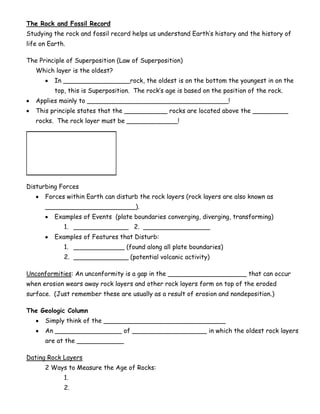
The rock and fossil record cloze notes
- 1. The Rock and Fossil Record Studying the rock and fossil record helps us understand Earth’s history and the history of life on Earth. The Principle of Superposition (Law of Superposition) Which layer is the oldest? In _________________rock, the oldest is on the bottom the youngest in on the top, this is Superposition. The rock’s age is based on the position of the rock. Applies mainly to ____________________________________! This principle states that the ___________ rocks are located above the _________ rocks. The rock layer must be _____________! Disturbing Forces Forces within Earth can disturb the rock layers (rock layers are also known as _______________________). Examples of Events (plate boundaries converging, diverging, transforming) 1. ______________ 2. _________________ Examples of Features that Disturb: 1. _____________ (found along all plate boundaries) 2. ______________ (potential volcanic activity) Unconformities: An unconformity is a gap in the ____________________ that can occur when erosion wears away rock layers and other rock layers form on top of the eroded surface. (Just remember these are usually as a result of erosion and nondeposition.) The Geologic Column Simply think of the _______________________________ An _________________ of ___________________ in which the oldest rock layers are at the ____________ Dating Rock Layers 2 Ways to Measure the Age of Rocks: 1. 2.
- 2. Relative Age The _______________________ of a rock is its age compared to other rocks. Use words like: “older or younger” Now you do an example of relative age!! _____________________________ ___________________________________________________________ ___________________________________________________________ ___________________________________________________________ “When Igneous Rock Meets Sedimentary Rock” o REMEMBER: Igneous Rock Lava that cools at the surface is called an_____________. Rock below an extrusion is always _______________. Magma that cools beneath the surface is called an_____________. An intrusion is always ________________ than the rock layers around. Absolute Age The _________________________ of a rock is the number of years since the rock was formed. Fossils Why is the study of fossils so important? _______________________________ The Beartooth Range of Montana is just north of Yellowstone. In this location you will find Beartooth Butte. Partway down from its 10,500 foot (3200 m) summit, within the dark red zone of rocks, geologists have found fish fossils as old as 400 million years. How is this possible? ____________________________________________ _____________________________________________________________ ____________________________________________________________ (Plate tectonics push up the rock making a mountain, weathering and erosion move the dirt and expose the marine fossil.) _______________can give us clues of what Earth’s surface looked like in the past. Fast Fossil Facts Fossils are the ______________________________________________ on Earth. Why are all dead organisms not preserved as fossils? 1. ____________________________________________________________ ____________________________________________________________ 2. ___________________________________________________________ _____________________________________________________________
- 3. o (When an organism dies, its soft parts often decay quickly leaving only the hard parts to fossilize.) Examples: ____________________________________ 1) Fossils provide clues to the past o Fossils give clues of ___________________ and ____________________. Examples: 1. Fossils of palm leaves in Antarctica could mean that Antarctica was once in a warm tropical area. (______________________) 2. Marine fossils found on mountain tops or land well above sea level. (____________________________) 2) Revisiting the Rock Cycle (Fossil Facts) 1. Fossils are generally most abundant in marine __________________________. 2. Fossils generally are not found in ____________________________________. 3. Most fossils found in __________________________________. Fossil Types 1. ________________: provide evidence of the activities of ancient organisms. Examples: ___________________, animal trails, or animal burrows. 2. _____________: a hollow area in sediment in the shape of an organism or part of an organism. 3. _____________: a copy of the shape of an organism. Other Types 4. _______________________: fossils in which minerals replace all or part of the organism. Ex: petrified wood 5. ______________________: an extremely thin coating of carbon on rock that forms when materials that make up an organism become gases and escape leaving only carbon behind. 6. _____________________: formed when an organism is preserved with little or no change. {For example when organisms become preserved in tar, amber (tree sap), and freezing.} Index Fossils An____________________ must be widely distributed and represent a type of organism that existed only briefly. One example of an index fossil is a _______________. Trilobites were a group of hard-shelled animals whose bodies had three distinct parts.They evolved in shallow seas more than 500 million years ago.